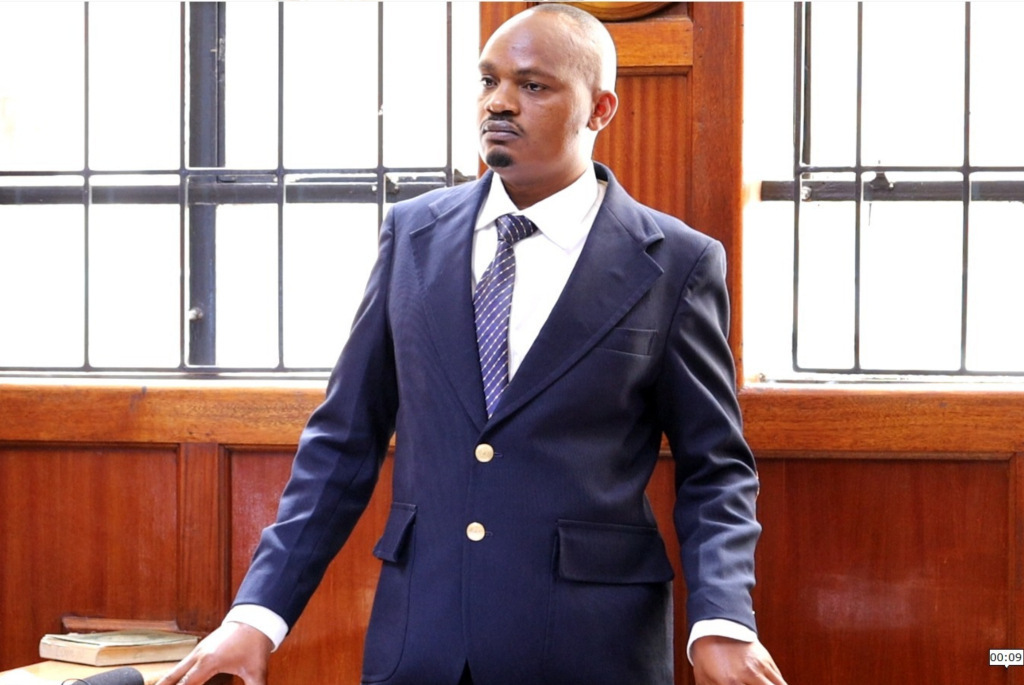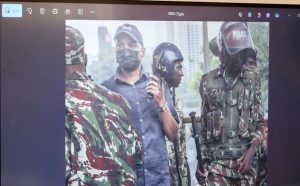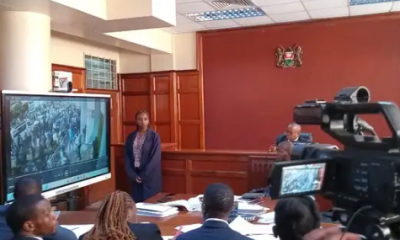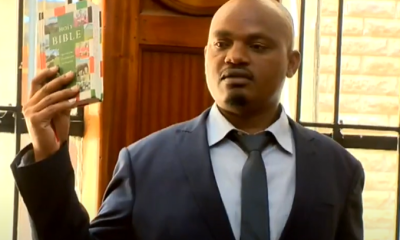News
‘It Wasn’t Me’: Police Officer Denies Involvement in Rex Masai Killing Despite Photo Evidence
Murangiri insisted he was stationed at the Kenyatta International Convention Centre (KICC) throughout the day and never left his assigned post.

Constable Isaiah Murangiri disputes IPOA photographic evidence despite striking resemblance and matching birthmark
NAIROBI – A pivotal moment unfolded in the Rex Masai death inquest yesterday as Police Constable Isaiah Murangiri categorically denied being the officer depicted in crucial photographs presented by the Independent Policing Oversight Authority (IPOA), despite what observers described as an unmistakable resemblance.
The dramatic confrontation at Milimani Law Courts marked Murangiri’s second appearance before Magistrate Geoffrey Onsaringo, where the officer maintained his innocence while facing mounting forensic evidence that appeared to contradict his testimony.
IPOA investigators presented what they described as damning photographic evidence allegedly captured on July 20, 2024 – the day 29-year-old Rex Masai was fatally shot during anti-government protests.
The images showed a man bearing what witnesses described as a “striking resemblance” to Murangiri.
The tension in the courtroom was palpable when IPOA officials highlighted a distinctive birthmark on the left side of Murangiri’s face that appeared identical to one visible on the individual in the photographs.
This physical evidence, combined with metadata extracted from the images and mobile phone records, reportedly placed Murangiri along Uhuru Highway on July 18, contradicting his earlier testimony.
Murangiri insisted he was stationed at the Kenyatta International Convention Centre (KICC) throughout the day and never left his assigned post.
He testified that he was in civilian clothes but claimed he could not recall what specific clothing he wore – a response that drew skeptical looks from the legal teams present.
The officer, who identified himself as part of the “Alpha-Mike” anti-mugging squad, maintained that he was off duty on July 18, 2024, caring for his sick child.
When directly questioned about using his teargas launcher during the protests, Murangiri denied firing at Rex Masai and claimed he received no operational instructions from the Nairobi County Commander that day.
Crime Scene Investigator Paul Njihia provided compelling testimony that painted a clearer picture of the events on Mama Ngina Street. His photographic evidence and scene sketches demonstrated that police had indeed opened fire on the location where Masai was killed.
A damaged bullet recovered at the scene was confirmed as live ammunition in a ballistic report dated August 8, 2024. Perhaps most significantly, blood swabs collected at the scene matched Rex Masai’s DNA, establishing definitively that he was killed at that location.
IPOA’s request for the court to compel submission of police arms movement records represents a critical step in establishing a paper trail that could definitively link specific officers to the use of lethal force.
Lawyers representing the Masai family strongly supported this move, arguing that certified arms movement records exist and should be treated as original documentation.
These records could prove crucial in determining which officers were armed with live ammunition on the day of the shooting.
Presiding Magistrate Geoffrey Onsaringo took decisive action, ordering that arms movement logs be handed over to the prosecution immediately.
He also directed all remaining officers who have not yet testified to present themselves to IPOA for investigation.
Rex Masai’s death during the June 20, 2024 anti-government protests became a flashpoint for public anger over police brutality and impunity.
The 29-year-old’s killing sparked widespread outrage and renewed calls for comprehensive police reform.
The inquest aims to establish definitively whether Masai was shot with live ammunition and, crucially, to identify who pulled the trigger.
With photographic evidence, DNA matches, and ballistic reports now part of the record, the case appears to be building toward a conclusion that could have significant implications for police accountability in Kenya.
The hearing resumes today, with expectations high that additional evidence will emerge to either support or refute Murangiri’s claims of innocence.
For the Masai family and advocates of police reform, the pursuit of justice continues in what has become a landmark case for accountability in Kenya’s security forces.
The inquest continues at Milimani Law Courts.
Kenya Insights allows guest blogging, if you want to be published on Kenya’s most authoritative and accurate blog, have an expose, news TIPS, story angles, human interest stories, drop us an email on [email protected] or via Telegram
-

 Business2 weeks ago
Business2 weeks ago‘They’re Criminals,’ Popular Radio Presenter Rapcha The Sayantist Accuses Electric Bike Firm Spiro of Fraudulent Practices
-

 Business1 week ago
Business1 week agoIt’s a Carbon Trading Firm: What Kenyans Need to Know About Spiro’s Business Model Amid Damning Allegations of Predatory Lending
-

 Business7 days ago
Business7 days agoManager Flees Safaricom-Linked Sacco As Fears Of Investors Losing Savings Becomes Imminent
-

 News1 week ago
News1 week agoWoman Accused in High Defamation Blames AI As Case Exposes How Mombasa Billionaire Mohamed Jaffer Allegedly Sponsored Smear Campaign Linking Joho’s Family To Drug Trafficking
-

 Investigations2 weeks ago
Investigations2 weeks agoDisgraced Kuscco Boss Arnold Munene Moves To Gag Media After Expose Linking Him To Alleged Sh1.7 Billion Fraud
-

 Africa1 week ago
Africa1 week agoDisgraced Oil Trader Idris Taha Sneaks Into Juba as Empire Crumbles
-

 Investigations2 weeks ago
Investigations2 weeks agoFraud: How Sh235 Million Donor Cash For Nyamira Residents Was Embezzled Through Equity Bank Under Governor Nyaribo’s Watch
-

 Sports2 weeks ago
Sports2 weeks ago1Win Games 2025: Ultimate Overview of Popular Casino, Sports & Live Games




















